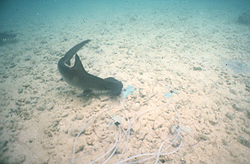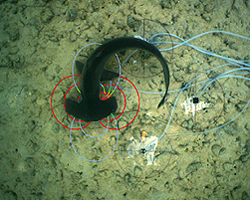Electroreception in Elasmobranchs
Elasmobranchs are renown for their ability to detect the weak bioelectric fields of their prey, even in the absence of other sensory cues. We have measured the bioelectric fields of prey items, quantified the behavioral responses to prey-simulating electric fields, and tested the efficacy of various electrogenic shark deterrents.
Enhanced electroreceptive capabilities may have driven selection for the unique head morphology of hammerhead sharks. The laterally expanded cephalofoil allows hammerheads to possess longer ampullae of Lorenzini tubules which might confer greater sensitivity to weak electric fields. In addition, by spacing the electrosensory pores over a broader area, the hammerhead sharks sample a larger swath of the substratum and thus increase the probability of prey encounter. These hypotheses were tested by comparing the behavioral response of juvenile scalloped hammerhead sharks to similar sized sandbar sharks that possess a typical requiem shark head morphology. Both species were exposed to prey-simulating dipole electric fields and their responses were recorded and quantified using digital video analysis. The sharks oriented to, and bit at the electric field as if it were a natural prey item. The hammerheads did not demonstrate greater sensitivity to the dipole electric fields but would likely demonstrate greater sensitivity if exposed to a large, uniform electric field where the greater ampullary tubule length would provide an advantage. Although they were not more sensitive, the hammerheads did sample a much greater area than the sandbar sharks with equivalent spatial resolution thus providing a greater probability of prey encounter.

Hammerhead shark maneuvering to bite at an
electric dipole.

Hammerhead shark biting at a dipole electric field;
the voltage equipotentials are shown in red.